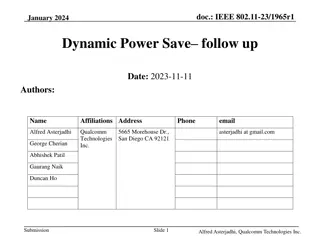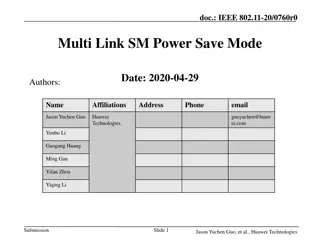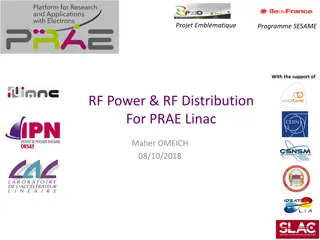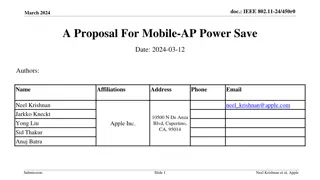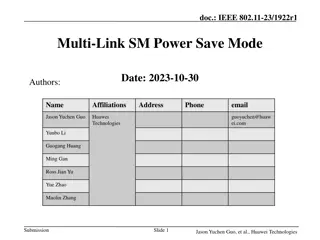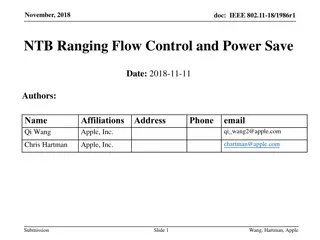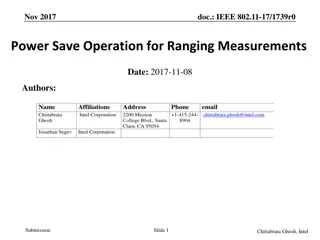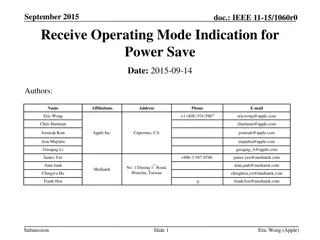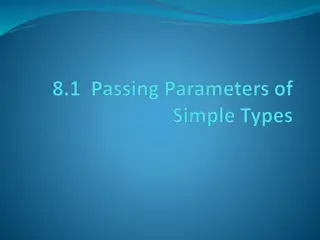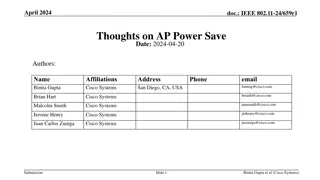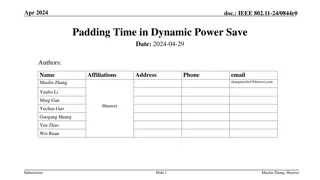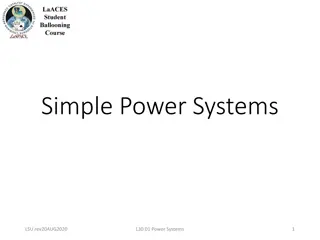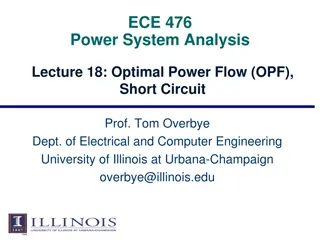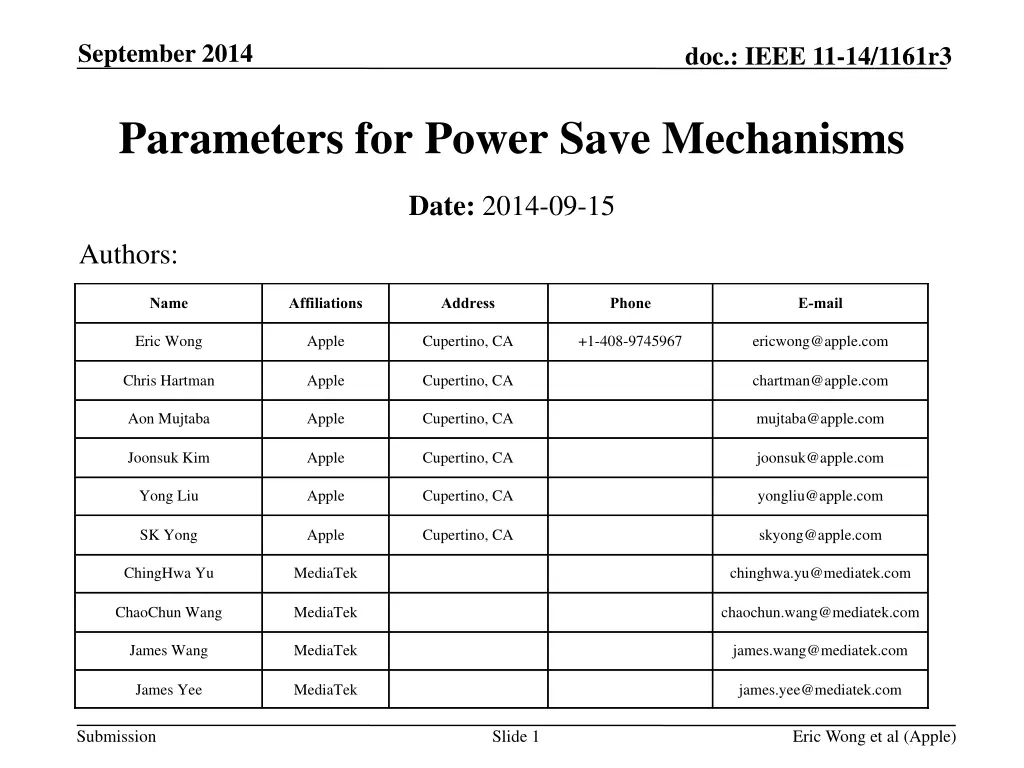
Parameters for Power Save Mechanisms in September 2014 IEEE Document
Explore the parameters associated with baseline power save mechanisms like PSM, PSP, and U-APSD as outlined in the September 2014 IEEE document. Dive into simulation values and definitions for optimal energy efficiency evaluation.
Download Presentation

Please find below an Image/Link to download the presentation.
The content on the website is provided AS IS for your information and personal use only. It may not be sold, licensed, or shared on other websites without obtaining consent from the author. If you encounter any issues during the download, it is possible that the publisher has removed the file from their server.
You are allowed to download the files provided on this website for personal or commercial use, subject to the condition that they are used lawfully. All files are the property of their respective owners.
The content on the website is provided AS IS for your information and personal use only. It may not be sold, licensed, or shared on other websites without obtaining consent from the author.
E N D
Presentation Transcript
September 2014 doc.: IEEE 11-14/1161r3 Parameters for Power Save Mechanisms Date: 2014-09-15 Authors: Name Affiliations Address Phone E-mail Eric Wong Apple Cupertino, CA +1-408-9745967 ericwong@apple.com Chris Hartman Apple Cupertino, CA chartman@apple.com Aon Mujtaba Apple Cupertino, CA mujtaba@apple.com Joonsuk Kim Apple Cupertino, CA joonsuk@apple.com Yong Liu Apple Cupertino, CA yongliu@apple.com SK Yong Apple Cupertino, CA skyong@apple.com ChingHwa Yu MediaTek chinghwa.yu@mediatek.com ChaoChun Wang MediaTek chaochun.wang@mediatek.com James Wang MediaTek james.wang@mediatek.com James Yee MediaTek james.yee@mediatek.com Submission Slide 1 Eric Wong et al (Apple)
September 2014 doc.: IEEE 11-14/1161r3 Authors: Name Affiliations Address Phone E-mail Chittabrata Ghosh Nokia chittabrata.ghosh@nokia.com Sayantan Choudhury Nokia sayantan.choudhury@nokia.com Jarkko Kneckt Nokia jarkko.kneckt@nokia.com Esa Tuomaala Nokia esa.tuomaala@nokia.com Submission Slide 2 Eric Wong et al (Apple)
September 2014 doc.: IEEE 11-14/1161r3 Outline Baseline power save mechanisms Summary of parameters for power save mechanisms Calibration test for MAC simulator Conclusion Submission Slide 3 Eric Wong et al (Apple)
September 2014 doc.: IEEE 11-14/1161r3 Baseline Power Save Mechanisms The contribution 11-14/827r3 [1] proposed to adopt one or more of the 3 existing power save mechanisms in 802.11-2012 [2] as baseline for energy efficiency evaluation Power save mode (PSM) Power save polling (PSP) Unscheduled automatic power save delivery (U-APSD) This is a follow up contribution discussing: Parameters associated with each baseline power save mechanism Calibration of the MAC simulator for power save mechanisms Submission Slide 4 Eric Wong et al (Apple)
September 2014 doc.: IEEE 11-14/1161r3 Summary of Parameters for Power Save Mechanisms Suggested Set of Simulation Values ** Mechanism Parameter Definition/Values Beacon Interval (BI) 100 TU 100 TU DTIM Integer in unit of BI { 1, 3 } Power save mode (PSM) Length of time before STA goes to sleep PSM timeout [5] { 50, 100, 200 } ms Beacon Interval 100 TU 100 TU Power save polling (PSP) DTIM Integer in unit of BI { 1, 3 } Beacon Interval 100 TU 100 TU DTIM Integer in unit of BI { 1, 3 } Unscheduled automatic power save delivery (U-APSD) Indicate the maximum number of buffered MSDUs, A-MSDUs, and MMPDUs that AP may deliver per SP Max SP Length { 2, 4, 6, } AC*** Access Category { VI, VO, BE, BK } ** Simulation results presented should clearly indicated what values are used in the generating the simulation results *** If U-APSD is enabled for an AC, then that AC is assumed to be both delivery and trigger enabled Submission Slide 5 Eric Wong et al (Apple)
September 2014 doc.: IEEE 11-14/1161r3 Example of PSM Operation AP is aware STA is out of PM mode, and no longer buffers traffic for this STA AP buffers this frame since this STA is in power save mode DATA STA starts CCA DtimCount=0 PM=0 PM=1 Beacon ACK ACK BA A-MPDU MPDU AP STA ACK BA A-MPDU PSM Timeout STA exits power save mode and is Awake for DTIM Beacon, i.e. DtimCount=0; STA skips other Beacons that are not DTIM PM=0 PM=1 AP starts CCA STA return to Doze, and AP resumes buffering traffic for this STA STA starts CCA for QOS frame with PM=0 Submission Slide 6 Eric Wong et al (Apple)
September 2014 doc.: IEEE 11-14/1161r3 Example of PSP Operation AP buffers this frame since this STA is in power save mode Since DTIM=3, STA continues in Doze state during this Beacon AP starts EDCA for downlink one MPDU DATA DtimCount=0 DtimCount=2 Beacon ACK MPDU Beacon AP STA PS-Poll ACK STA exits power save mode and is Awake for DTIM Beacon, i.e. DtimCount=0; STA skips other Beacons that are not DTIM Beacons STA starts CCA for PS-Poll STA return to Doze, and AP resumes buffering traffic for this STA Submission Slide 7 Eric Wong et al (Apple)
September 2014 doc.: IEEE 11-14/1161r3 Example of U-APSD Operation AP is aware STA is Awake, starts EDCA, and send frames to STA until there are no more data frames for this AC or AP has reached Max SP Length AP buffers this frame since this STA is in power save mode STA return to Doze, and AP resumes buffering traffic for this STA DATA DtimCount=0 DtimCount=2 EOSP=0 EOSP=1 Beacon Beacon ACK A-MPDU A-MPDU AP STA BA BA MPDU STA exits power save mode and is Awake for DTIM Beacon, i.e. DtimCount=0; STA skips other Beacons that are not DTIM Beacons STA starts CCA for trigger frame, i.e. QoS (Null) frame Service Period Submission Slide 8 Eric Wong et al (Apple)
September 2014 doc.: IEEE 11-14/1161r3 Calibration Test for MAC Simulator STA AP Power Save Test Parameters Goal Traffic model: Voice This test case is intended to verify the baseline power save mechanism implemented in MAC system simulator MSDU length: [ 120 bytes (assuming 24 kbps codec, once every 40 ms) for both AP and STA ] RTS/CTS [ OFF ] MCS = [ 0 ] Assumptions PER = 0 Power model = [ PSM, PSP, U-APSD ] DTIM = [ 3 ] Max SP Length = [ 4 ] Common Parameters Long GI, 11ac preamble, 20MHz Aggregation A-MPDU Fixed MCS Transport protocol: UDP EDCA parameters: BE (CWmin = 15), VI (CWmin = 7) PSM timeout = [ 100 ] ms Output MAC throughput Per STA energy per TX bit Per STA energy per RX bit Pie chart (breakdown) of time spent in each power state [1] during the course of the simulation Submission Slide 9 Eric Wong et al (Apple)
September 2014 doc.: IEEE 11-14/1161r3 Conclusion This contribution discusses parameters associated to each baseline power save mechanism, and proposed a MAC simulator calibration test for each power save mechanism Submission Slide 10 Eric Wong et al (Apple)
September 2014 doc.: IEEE 11-14/1161r3 Straw Poll 1 Do you agree to define parameters associated with each power save mechanism to the simulation scenario document (11-14/980r2)? Yes No Abstain Submission Slide 11 Eric Wong et al (Apple)
September 2014 doc.: IEEE 11-14/1161r3 Straw Poll 2 Do you agree to add a test for power save mechanisms to the simulation scenario document (11-14/980r2) in the Scenarios for calibration of MAC simulator section? Yes No Abstain Submission Slide 12 Eric Wong et al (Apple)
September 2014 doc.: IEEE 11-14/1161r3 References 1. 2. 3. 4. 5. E. Wong et al, Energy Efficiency Evaluation Methodology, IEEE 11-14-827r3 IEEE 802.11-2012 S. Merlin et al, TGax Simulation Scenarios, IEEE 11-14-980r2 R. Porat et al, 11ax Evaluation Methodology, IEEE 11-14-571r2 Y. Xiao et al, Modeling Energy Consumption of Data Transmission over Wi-Fi, IEEE Transactions on Mobile Computing, 2014 Submission Slide 13 Eric Wong et al (Apple)


